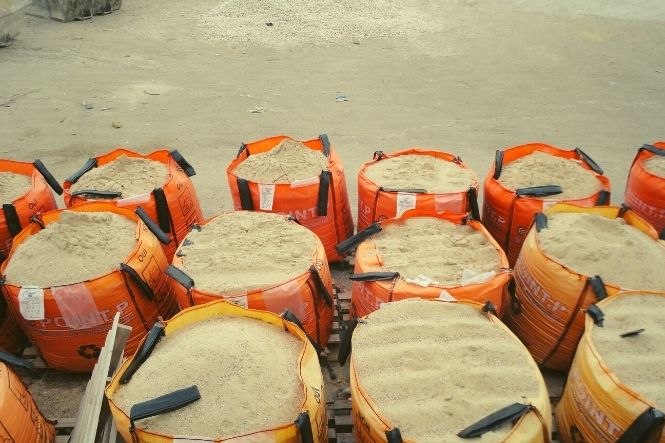There’s more than one way to produce concrete. Sands and the many variations of aggregates that go into construction materials are really quite extensive. Check out our latest article to see just what goes into what and how it found it’s way below your very feet.
Without sand, there is no concrete, mortar, cement, or asphalt. The choice of aggregate is important. Even the ancient Romans knew that, as they routinely used “pit sand” in their mortar, which was essentially volcanic dust.
There are—speaking from a pure construction standpoint—seven types of sand that go into different mixtures, whether it’s grout, concrete, cement, or asphalt. It provides stability and gives the mixture its structure.
The following are the seven types of sand:
- Fill Sand
- Utility Sand
- Masonry Sand
- Industrial Sand
- Concrete Sand
- Crushed Limestone Sand
- Crushed Stone Sand
Of course, other lists may have a larger number of sand types and some will have fewer, however, they all usually fall under one of the above seven in terms of categorization.
Table of Contents
Fill Sand
Fill sand generally has a high compaction rating. It can withstand a ton of pressure and is often used in wet areas, such as septic tanks and drainage systems. Its also used as a base layer before concrete is poured in over it.
Since it is relatively cheap, it’s often sought after by contractors over other sand that would probably be better choices for different types of construction. It does compact very hard and is difficult—when fully compacted—for water to breach.
Utility Sand
When you want superior durability, excellent compaction, and a powerful foundation for heavy buildings, you go with utility sand. Utility sand is quartz, crushed into finer particulates, and often used as a fill.
It’s especially useful in areas where there will be a lot of acids since quartz is a non-reactive mineral. Quartz is 100% all-natural so it makes for an excellent environmental choice as well as with durability and long-term stability.
This makes it an excellent base material for a concrete slab pour, as a fill material, or beneath paving stones.
Masonry Sand
Masonry sand is aptly named because it is often used as the aggregate in masonry compounds, such as mortar, grout, and sometimes concrete. It is very fine sand with the same feel and texture as the sand most prevalent on beaches.
Masonry sand is used for mortar more than any other use. Masonry sand is often the aggregate in the composition used and spread by brick masons, between the bricks.
Masonry sand is also used for paved recreational areas such as volleyball or tennis courts. It has a very smooth finish that’s still textured enough to provide athletes with excellent traction and the ability to pivot quickly on their feet.
Industrial Sand
Industrial sand is typically reserved for specialty construction projects. It is made of silica that is ground down into a fine, powdery aggregate that’s perfect for a non-skid surface, roofing tiles, and asphalt compounds.
It also goes well beyond the concrete and mortar business. Since it is 100% silica, it is also pulverized and used to form glass in building windows and vehicles. It can even be processed small enough to go into fiberglass insulation and glass fibers.
Concrete Sand
Concrete sand is simply the result of crushing existing concrete back down into its sandy components. It’s an excellent way to reuse exiting concrete, which is, of course, helpful to the overall environment.
Once it’s crushed back down, it can be used to form leveling pasts for patios and pathways. While it can be used as a filler, it’s often not since there are better and more readily available sands for that.
Since it is a softer material it is most often used in softer construction projects, such as sidewalks, speed bumps, and parking stops.
Crushed Limestone Sand
Since limestone doesn’t do so great with water, its crushed form is mostly used for indoor concrete projects, such as enclosed patios, and beneath other concrete projects.
While limestone doesn’t react well to water it does have an excellent compaction capability so it can often be found as a base layer beneath roadways, building slabs, and parking lots.
It also has the neat side-effect of being a good soil regulator as it reduces the pH of the soil.
Crushed Stone Sand
This is a type of M-sand (Manufactured sand) because it goes through a meticulous and arduous crushing process before it is broken down to its ideal proportions. It’s an angular aggregate so it is used in the construction of specialty types of roads, like macadam.
It will often find its way into concrete compounds that are used in residential construction and office buildings as well as in lawn and gardening as a fill material for patios and pathways.
Last But Not Least
In the world of construction, there’s literally an aggregate type for everything. If you’ve ever been in a field engineering lab, they have rows and rows of sifters and automated machinery designed just for the sole purpose of testing sand aggregates.
The next time you walk outside on a sidewalk, in your driveway, or just on a patio, you can appreciate the sheer volumes of sand that went into the concrete beneath your feet and probably below that too.


